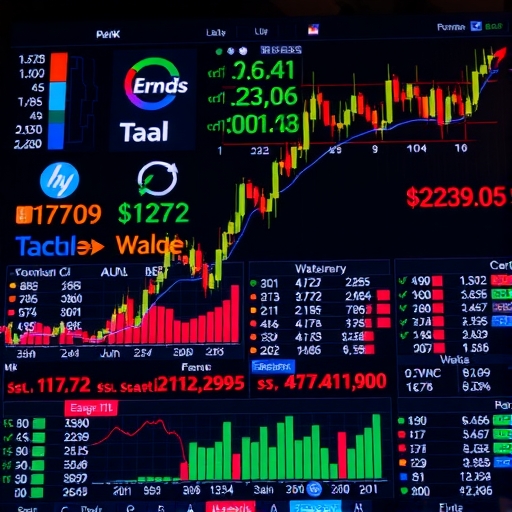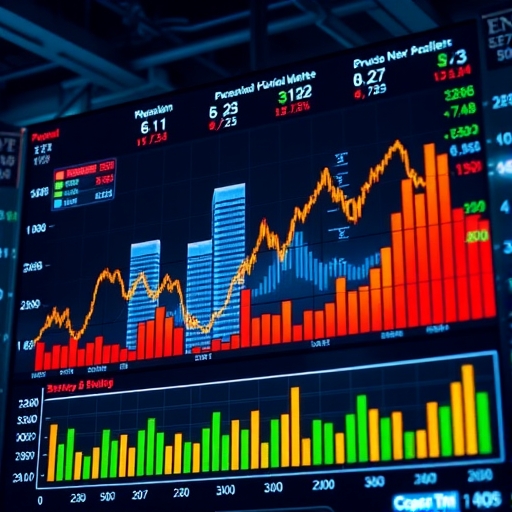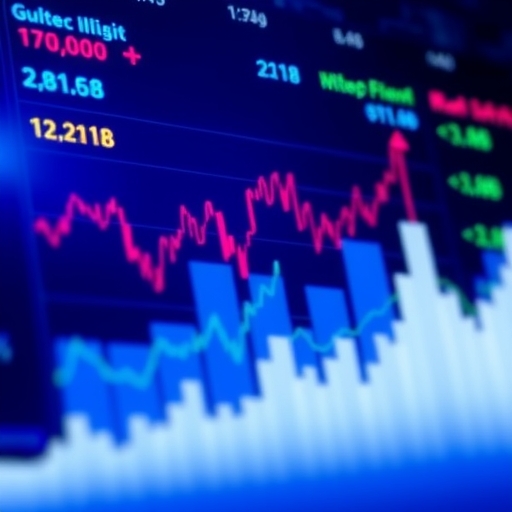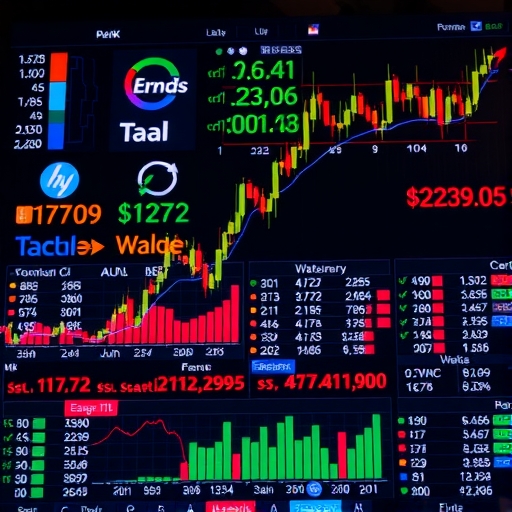Navigating the U.S. Treasury Futures Market: A Comprehensive Guide
Have you ever wondered how large institutions and savvy investors manage their exposure to the ever-changing landscape of U.S. government debt? Investing in financial derivatives, particularly Treasury futures, can appear complex, yet these instruments are indispensable for navigating the U.S. government bond market. Whether you’re aiming to hedge against interest rate fluctuations, speculate on market movements, or optimize portfolio duration, a deep understanding of Treasury futures is paramount. In this article, we will explore everything from foundational contract mechanics and underlying bond market principles to advanced trading strategies, risk management, and the unique dynamics of innovative products like Micro Treasury Yield Futures and the critical cash-futures basis trade.

Our journey will cover the core concepts of these powerful contracts, examine the economic forces that drive their value, and equip you with insights into managing the associated risks. We will also delve into specific market innovations and crucial trading strategies that shape the daily operations of the Treasury market. By the end, you’ll have a clearer picture of how these sophisticated tools function and why they are so vital to the global financial system.
Understanding Treasury Futures: Core Concepts and Mechanics
What exactly are Treasury futures? At their heart, they are standardized, legally binding contractual agreements to buy or sell a specific U.S. government debt instrument—like a Treasury bond, note, or bill—at a predetermined price on a future date. These contracts are not about physically taking delivery of bonds for most traders; instead, they are primarily used for managing interest rate risk or speculating on the future direction of rates.
Several key characteristics make Treasury futures a powerful tool in the financial world:
- Standardization: Each contract has a uniform size, maturity, and quality, ensuring that all participants are trading the exact same instrument. This standardization is crucial for high market liquidity.
- Margin Requirements: To trade futures, you don’t pay the full value of the contract upfront. Instead, you deposit a smaller amount, known as margin, which acts as a good faith deposit. This leverage can amplify both gains and losses.
- High Liquidity: The Treasury futures market is one of the most liquid derivatives markets globally. This means you can typically enter and exit positions quickly without significantly impacting prices.
- Hedging Tool: Futures are extensively used by investors to protect their existing bond portfolios from adverse interest rate movements. Think of it like taking out insurance on your bond holdings.
In addition to these core features, several other aspects bolster the Treasury futures market’s appeal:
- Price Discovery: Futures prices often act as leading indicators for interest rate expectations, influencing cash bond prices and providing valuable insights into market sentiment.
- Capital Efficiency: Due to margin requirements, futures allow participants to gain significant exposure to the Treasury market with a relatively small upfront capital outlay, optimizing capital utilization.
- Regulatory Oversight: The market operates under strict regulatory frameworks, such as those imposed by the CFTC in the U.S., which helps ensure transparent and fair trading practices, protecting market integrity.

Let’s look at some contract fundamentals. A typical Treasury note futures contract might represent a notional face value of $100,000. Price movements are quoted in “points” and “32nds of a point.” For example, a change of 1/32nd of a point is often worth $31.25 per contract. Futures contracts also involve specific delivery options. When a contract reaches its maturity date, the seller (short position holder) has the option to deliver one of several eligible U.S. Treasury securities that fall within a predefined “delivery basket.” The seller will almost always choose the bond that is most economically advantageous to deliver, known as the Cheapest-to-Deliver (CTD) security. This choice is influenced by factors like the bond’s coupon, maturity, and a conversion factor that adjusts its price to the futures contract.
The Interplay of Bond Markets, Economic Forces, and Futures Strategies
To truly understand Treasury futures, we must first grasp the basics of the underlying bond market and the powerful economic forces that influence it. The most fundamental concept is the inverse relationship between interest rates and existing bond prices. Imagine you bought a bond last year that pays a fixed 2% interest. If new bonds being issued today offer 4% interest due to rising rates, your older 2% bond becomes less attractive. To sell your 2% bond, you’d have to lower its price significantly to make its effective yield competitive with the new 4% bonds. Conversely, if interest rates fall, your 2% bond becomes more valuable because it offers a higher yield than newly issued bonds.
Supply and demand dynamics also play a massive role. The U.S. government issues vast amounts of Treasury securities to finance its spending. The demand for this debt comes from a wide range of global investors, including central banks, asset managers, and individuals. This interplay of supply and demand significantly influences the pricing of both cash Treasuries and their corresponding futures contracts.
Beyond these mechanics, economic factors are the ultimate drivers. Treasury futures are highly sensitive to macroeconomic indicators such as inflation rates, Gross Domestic Product (GDP) growth, and employment data. For example, if inflation is rising, the Federal Reserve (often called “the Fed”) might raise interest rates to cool the economy, which would typically cause bond prices to fall and futures prices to decline. Therefore, understanding the Fed’s policy decisions is critical for anyone trading in this market.
To further illustrate the impact of macroeconomic events, consider the following table which outlines common indicators and their general influence on Treasury futures prices. Please note that market reactions can sometimes diverge from these general trends due to other prevailing factors.
| Economic Indicator | Typical Impact on Interest Rates | Typical Impact on Treasury Futures Prices |
|---|---|---|
| Strong GDP Growth | Upward pressure (Fed may tighten) | Downward pressure |
| Rising Inflation | Upward pressure (Fed may tighten) | Downward pressure |
| Weak Employment Data | Downward pressure (Fed may ease) | Upward pressure |
| Lower Consumer Confidence | Downward pressure | Upward pressure |

With this foundation, let’s explore popular futures trading strategies:
- Hedging: As we discussed, this is about minimizing risk. For instance, an institutional investor holding a large portfolio of U.S. Treasury bonds might sell Treasury futures contracts to offset potential losses if interest rates rise. If rates do rise, the losses on their cash bonds would be offset by gains on their short futures position.
- Speculation: This strategy involves taking a position in the futures market based on your prediction of future interest rate movements. If you believe rates will fall (and bond prices will rise), you might buy (go long) Treasury futures. If you expect rates to rise, you would sell (go short) futures.
- Spread Trading: This involves simultaneously taking positions in two related futures contracts to profit from the difference in their prices. For example, you might buy a 2-year Treasury future and sell a 10-year Treasury future, betting on how the yield curve will change.
- Arbitrage: Sophisticated traders look for small, temporary price discrepancies between the cash Treasury bond market and the futures market. By simultaneously buying the undervalued asset and selling the overvalued one, they aim to profit from these fleeting inefficiencies with minimal risk.
Navigating Risk and Valuing Futures: Essential Mathematical Insights
Trading Treasury futures, while offering significant opportunities, also comes with inherent risks, especially given the element of leverage. Effective risk management is not just important; it’s essential for long-term success. Here are some key tactics:
- Stop-Loss Orders: These automatically close out a position if the market moves against you by a predetermined amount, limiting potential losses.
- Diversification: Spreading your investments across different assets or strategies can reduce the impact of a poor performance in any single area.
- Careful Position Sizing: Never allocate too much of your capital to a single trade. Determine a comfortable percentage of your total trading capital to risk on any given position.
- Stress Testing: Imagine “worst-case scenarios” and analyze how your portfolio would perform under extreme market conditions.
- Regular Monitoring: Stay constantly updated on economic data, Federal Reserve announcements, and geopolitical events that can rapidly influence market sentiment.
Despite the high liquidity of the Treasury market, certain inherent risks always loom. Market volatility, where prices can swing rapidly due to unexpected news or shifts in economic outlook, is a constant concern. While generally highly liquid, even the most active markets can experience periods of reduced liquidity risk, especially during times of stress, making it harder to exit positions at favorable prices. And of course, leverage risk is paramount; while it can amplify gains, it can equally amplify losses, potentially exceeding your initial margin deposit.
Understanding the various forms of risk is paramount for effective trading. The table below summarizes key risks associated with Treasury futures, highlighting the challenges traders must actively manage.
| Risk Type | Description | Mitigation Strategy Example |
|---|---|---|
| Market Volatility Risk | Rapid and unpredictable price swings due to news or economic shifts. | Using stop-loss orders, reducing position size during high volatility. |
| Liquidity Risk | Difficulty in entering or exiting positions at favorable prices, especially in stressed markets. | Trading highly liquid contracts, diversifying across different maturities. |
| Leverage Risk | Amplified gains and losses due to trading with borrowed capital. | Careful position sizing, adhering strictly to risk limits, maintaining sufficient margin. |
| Interest Rate Risk | The value of bond-related assets changing due to interest rate fluctuations. | Hedging with futures, matching duration of assets and liabilities. |
Understanding the basic math behind Treasury futures can help you appreciate their value. Pricing Treasury futures is not as simple as just looking at the underlying bond’s price. It’s derived from that price, but adjusted for the cost-of-carry. This “cost” includes the financing cost of holding the underlying bond (e.g., the interest you might pay on a loan to buy the bond) minus any coupon payments you would receive from the bond, all adjusted for the time until the futures contract matures. Sophisticated models incorporate risk-free rates and time to maturity to arrive at a fair futures price.
Another crucial concept is yields and duration. A bond’s yield is essentially the annual percentage rate of return an investor would receive. Duration is a key measure of a bond’s price sensitivity to changes in interest rates. A bond with a higher duration will experience a larger price change for a given change in interest rates compared to a bond with a lower duration. For hedging purposes, the modified duration is particularly important, as it estimates the percentage change in a bond’s price for a 1% change in yield. Understanding these mathematical concepts, even at a high level, provides a deeper insight into how market movements translate into profit or loss.
The Evolving Landscape: Micro Treasury Yields and Basis Trade Dynamics
The Treasury futures market is continuously innovating to meet the needs of a diverse range of participants. One such innovation is the introduction of Micro Treasury Yield Futures by the CME Group. Unlike traditional Treasury futures which track the price of a notional bond, these contracts track the actual yields of Treasury securities directly. This offers a distinct and potentially more intuitive way to trade and hedge interest rate exposure, especially for retail traders or those looking for more granular control over specific points on the yield curve. These new contracts are available for 2-year, 5-year, 10-year, and 30-year Treasury yields.
Here are some key specifications for Micro Treasury Yield Futures:
- Tick Value: A standardized $1.00 per 0.001% (or 1 basis point) tick, making price movements very clear.
- Cash Settlement: These contracts are cash-settled, meaning there is no physical delivery of bonds. Instead, the final profit or loss is simply settled in cash.
- Monthly Maturities: They offer monthly maturities, providing more flexibility for short-term trading and hedging.
- Lower Margin Requirements: Designed to be more accessible, they typically have lower margin requirements compared to traditional Treasury futures contracts.
The introduction of Micro Treasury Yield Futures marks a significant evolution, offering distinct advantages for certain market participants compared to traditional Treasury futures. A comparative overview helps highlight these differences and benefits.
| Feature | Traditional Treasury Futures | Micro Treasury Yield Futures |
|---|---|---|
| Underlying Asset | Notional Treasury bond price | Actual Treasury yield (e.g., 2yr, 10yr) |
| Contract Size | Larger ($100,000 notional) | Smaller (tracks yield directly, $1.00 per 0.001%) |
| Settlement | Physical delivery (Cheapest-to-Deliver) or cash-settled | Cash-settled only |
| Margin Requirements | Higher | Lower, more accessible |
| Trading Focus | Price movements, hedging large portfolios | Yield movements, granular yield curve exposure |
If you’re considering trading Micro Treasury Yield Futures, here’s a simplified process:
- Education: Understand how yields work and their relationship to economic data.
- Strategy Selection: Decide if you want to speculate on yield movements or hedge an existing fixed-income position.
- Opportunity Identification: Analyze market trends and economic forecasts to identify potential trading opportunities.
- Product and Month Selection: Choose the specific yield (e.g., 10-year) and contract month that aligns with your view.
- Understand Margin: Be aware of the margin required to open and maintain your position.
- Order Placement: Place your buy or sell order through a futures broker.
- Position Monitoring: Continuously monitor your position and market news, adjusting your strategy as needed.
Another crucial dynamic in the Treasury market is the Treasury cash-futures basis trade. This is a large, highly leveraged strategy often employed by hedge funds. It typically involves simultaneously taking a long position in cash Treasuries (buying the actual bonds) and a short position in Treasury futures contracts. The aim is to profit from the small difference (the “basis”) between the cash price of a bond and its futures price. This trade is incredibly sensitive to market conditions, particularly funding costs and the ability of financial intermediaries (like banks) to facilitate these large-scale operations.
Recent history has shown the critical nature of this trade. During the March 2020 pandemic shock, a rapid unwinding of these basis positions amplified market stress significantly. However, it’s important to note that the trade remained notably stable during the April 2025 market turbulence, indicating a resilience in intermediation capacity. This stability is more sensitive to declines in dealer intermediation capacity and the supply of repo funding (short-term loans collateralized by Treasuries) than to direct increases in funding rates themselves. Factors like higher volatility, expectations of policy easing by the Federal Reserve, rising yields, and a steepening yield curve can sometimes align favorably for these basis positions, creating “right-way” risk exposure where market conditions support the trade.
Market Structure and Resilience: Participant Roles and Delivery Design
The strength and efficiency of the Treasury futures market come from its diverse ecosystem of participants and its robust design. The market attracts a wide array of financial entities, each with unique needs and strategies:
- Global Banks: Use futures for hedging their vast portfolios, managing interest rate risk, and as part of their market-making activities.
- Asset Managers: Employ futures to manage portfolio duration, gain synthetic exposure to Treasuries without buying cash bonds, and enhance capital efficiency.
- Hedge Funds: Utilize futures for relative value strategies, speculation, and the aforementioned cash-futures basis trade, contributing significantly to market liquidity and price discovery.
- Central Banks and Sovereign Wealth Funds: Manage their substantial reserves and engage in open market operations.
- Pension, Insurance, and Mortgage Companies: Hedge their long-term liabilities against interest rate changes.
- Proprietary Trading Firms: Engage in high-frequency trading and algorithmic strategies to capitalize on short-term market movements.
These participants engage in various use cases, including hedging cash Treasury positions, managing duration risk, algorithmic market-making, expressing directional views on interest rates, and executing complex relative value strategies such as yield curve trades, invoice spreads, and basis spreads. The market has seen substantial growth; for example, leveraged accounts’ net short futures positions have increased significantly, reflecting their prominent role. However, as the overall marketable U.S. debt has also grown, their percentage of the total market has, in some instances, proportionally decreased, highlighting the sheer scale of the Treasury market.

A critical element enabling this market’s success and liquidity is its unique delivery basket-based design. Introduced in 1977, this mechanism allows the short position holder (the seller) in a futures contract to deliver any one of a predetermined set of eligible bonds that meet specific criteria. This design aggregates liquidity across multiple cash Treasury securities, rather than concentrating it on a single bond, making the market incredibly efficient and supportive of exponential growth. Today, the open interest in Treasury futures is a staggering $2.3 trillion, underscoring its pivotal role.
The delivery options inherent in this design, such as the “Timing of Delivery” and “Quality of Delivery” (choosing the Cheapest-to-Deliver or CTD security), are consequences of the design, not the primary intent for physical acquisition. In fact, over 98% of Treasury futures positions are rolled forward to subsequent contract months rather than resulting in physical delivery. This emphasizes their function as tools for risk management and speculative exposure, not for acquiring the underlying bonds. While CTD switches (when a different bond becomes the cheapest to deliver) are rare, they are factored into futures pricing, reflecting the market’s sophisticated understanding of these intricacies.
Conclusion: The Enduring Value of Treasury Futures
Treasury futures stand as a sophisticated yet accessible cornerstone for investors seeking to engage with the intricate dynamics of the U.S. government bond market. From their foundational role as standardized derivative contracts to their use in advanced strategies like the cash-futures basis trade and innovative products such as Micro Treasury Yield Futures, these instruments provide unparalleled efficiency and liquidity for risk transfer. Understanding the inverse relationship between interest rates and bond prices, recognizing the impact of economic indicators and Federal Reserve policy, and implementing astute trading and risk management strategies are key to harnessing their power.
The continuous evolution of this market, exemplified by innovations and its proven resilience even during periods of significant market stress, underscores the importance of ongoing learning and adaptability. Whether you are an institutional investor managing vast portfolios or an individual trader seeking to understand interest rate movements, mastering the concepts behind Treasury futures offers invaluable knowledge for thriving in today’s dynamic financial environment.
Disclaimer: This article is for informational and educational purposes only and does not constitute financial advice. Trading in futures contracts involves significant risk and is not suitable for all investors. You could lose more than your initial investment. Consult with a qualified financial professional before making any investment decisions.
Frequently Asked Questions (FAQ)
Q: What is the primary purpose of Treasury futures?
A: Treasury futures are primarily used by investors and institutions to manage interest rate risk, speculate on future interest rate movements, and enhance the capital efficiency of their portfolios. They provide a standardized way to gain exposure to the U.S. government bond market without directly buying physical bonds.
Q: How do interest rates affect Treasury futures prices?
A: There is an inverse relationship between interest rates and Treasury futures prices. When interest rates rise, the value of existing bonds (and thus futures contracts) typically falls, and vice versa. This is because higher new yields make older, lower-yielding bonds less attractive, requiring their prices to drop to compete.
Q: What is the Cheapest-to-Deliver (CTD) security in Treasury futures?
A: The Cheapest-to-Deliver (CTD) security is the specific U.S. Treasury bond within a predefined delivery basket that the seller (short position holder) of a Treasury futures contract chooses to deliver upon maturity because it is the most economically advantageous option for them. This choice is influenced by the bond’s coupon, maturity, and a conversion factor.



No responses yet